Design and Performance Research of a New Dual-Excitation Uniform Eddy Current Probe
Abstract
:1. Introduction
2. Theoretical Research
2.1. The Crack Defect Test Principle of a UEC Probe
2.2. Establishment and Characteristic Analysis of the Simulation Model
2.3. Optimization of Distance between Excitation Coils
2.4. Influence of Crack Defect Depth on Test Signal
2.5. Influence of Crack Defect Direction on Test Signal
3. Experiment and Results
3.1. The Testing of Crack Defects with Different Depths
3.2. The Testing of Crack Defects with Different Directions
3.3. The Testing of the Probe’s Measurement Accuracy
4. Discussion
5. Conclusions
Author Contributions
Funding
Institutional Review Board Statement
Informed Consent Statement
Conflicts of Interest
References
- Ramos, H.G.; Ribeiro, A.L. Present and Future Impact of Magnetic Sensors in NDE. Procedia Eng. 2014, 86, 406–419. [Google Scholar] [CrossRef] [Green Version]
- Chen, T.; He, Y.; Du, J. A High-Sensitivity Flexible Eddy Current Array Sensor for Crack Monitoring of Welded Structures under Varying Environment. Sensors 2018, 18, 1780. [Google Scholar] [CrossRef] [Green Version]
- Bettaieb, L.; Kokabi, H.; Poloujadoff, M.; Krauss, H.J.; Coillot, C. Comparison of the Use of SQUID and Hall Effect Sensors in Nondestructive Testing. Mater. Eval. 2010, 68, 535–541. [Google Scholar]
- Chen, G.; Zhang, W.; Zhang, Z.; Jin, X.; Pang, W. A new rosette-like eddy current array sensor with high sensitivity for fatigue defect around bolt hole in SHM. NDT E Int. 2018, 94, 70–78. [Google Scholar]
- Zheng, D.; Dong, Y. A Novel Eddy Current Testing Scheme by Transient Oscillation and Nonlinear Impedance Evaluation. IEEE Sens. J. 2018, 18, 4911–4919. [Google Scholar] [CrossRef]
- Li, Y.; Liu, Z.; Yan, B.; Wang, Y.; Zainal Abidin, I.M.; Chen, Z. A funnel-shaped probe for sensitivity enhancement in pulse-modulation eddy current inspection of subsurface flaws in conductors. Sens. Actuators A Phys. 2020, 307, 111991. [Google Scholar] [CrossRef]
- Rosado, L.S.; Santos, T.G.; Ramos, P.M.; Vilaca, P.; Piedade, M. A differential planar eddy currents probe: Fundamentals, modeling and experimental evaluation. NDT E Int. 2012, 51, 85–93. [Google Scholar]
- Wu, D.; Cheng, F.; Yang, F.; Huang, C. Non-destructive testing for carbon-fiber-reinforced plastic (CFRP) using a novel eddy current probe. Compos. Part B Eng. 2019, 177, 107460. [Google Scholar] [CrossRef]
- Koyama, K.; Hoshikawa, H.; Taniyama, N. Eddy current testing of weld zone using uniform eddy current probe. J. Jpn. Soc. Non-Destr. Insp. 2001, 50, 321–327. [Google Scholar]
- Hoshikawa, H.; Koyama, K.; Kawate, Y. Electromagnetic Surface Testing of Weld Over Painting by Uniform Eddy Current Probe. AIP Conf. Proc. 2007, 894, 1103. [Google Scholar]
- Linnan, H.; Chunhui, L.; Xiaochun, S.; Tao, C.; Xu, Z.; Zhiyang, D. Research on Detection Mechanism of Weld Defects of Carbon Steel Plate Based on Orthogonal Axial Eddy Current Probe. Sensors 2020, 20, 5515. [Google Scholar]
- Jiuhao, G.; Fanwei, Y.; Takuma, T.; Haicheng, S.; Noritaka, Y. Inspection of Pitting Corrosions on Weld Overlay Cladding Using Uniform and Rotating Eddy Current Testing. IEEE Trans. Instrum. Meas. 2021, 70, 6010410. [Google Scholar]
- Jiuhao, G.; Chenkai, Y.; Fanwei, Y.; Noritaka, Y. Transformation of the rotating eddy current testing signal at the desired eddy current orientation. NDT E Int. 2022, 125, 102551. [Google Scholar]
- Yusa, N.; Hashizume, H.; Urayama, R.; Uchimoto, T.; Takagi, T.; Sato, K. An arrayed uniform eddy current eprobe design for crack monitoring and sizing of surface breaking cracks with the aid of a computational inversion technique. NDT E Int. 2014, 61, 29–34. [Google Scholar]
- Repelianto, A.S.; Kasai, N. The Improvement of Flaw Detection by the Configuration of Uniform Eddy Current Probes. Sensors 2019, 19, 397. [Google Scholar] [CrossRef] [Green Version]
- Hang, X.; Donglin, L.; Tao, C.; Xiaochun, S. Simultaneous measurement of thickness and lift-off using the tangential component of magnetic flux density in pulsed eddy current testing. Insight Non-Destr. Test. Cond. Monit. 2021, 63, 341–347. [Google Scholar]
- Hoshikawa, H.; Koyama, K. Uniform Eddy Current Probe with Little Disrupting Noise. In Review of Progress in Quantitative Nondestructive Evaluation; Springer: Boston, MA, USA, 1998; pp. 1059–1066. [Google Scholar]
- Faraj, M.A.; Samsuri, F.; AbdAlla, A.N.; Rifai, D.; Ali, K.; Al-Douri, Y. Hybrid GMR/IR probe to reduce the effects of lift-off. Meas. Control 2019, 52, 588–598. [Google Scholar] [CrossRef] [Green Version]
- Repelianto, A.S.; Kasai, N.; Sekino, K.; Matsunaga, M. A Uniform Eddy Current Probe with a Double-Excitation Coil for Flaw Detection on Aluminium Plates. Metals 2019, 9, 1116. [Google Scholar] [CrossRef] [Green Version]
- Postolache, O.; Ramos, H.G.; Ribeiro, A.L.; Alegria, F.C. GMR based eddy current sensing probe for weld zone testing. In Proceedings of the SENSORS IEEE, Christchurch, New Zealand, 25–28 October 2009; pp. 73–78. [Google Scholar]
- Rifai, D.; Abdalla, A.N.; Ali, K.; Razali, R. Giant Magnetoresistance Sensors: A Review on Structures and Non-Destructive Eddy Current Testing Applications. Sensors 2016, 16, 298. [Google Scholar] [CrossRef] [Green Version]
- Chen, T.; Xiao, X.; Zhang, L.; Lv, C.; Deng, Z.; Song, X. Design of orthogonal eddy-current probe for weld crack detection of carbon-steel plate. Int. J. Appl. Electromagn. Mech. 2020, 64, 1347–1355. [Google Scholar] [CrossRef]
- Abdalla, A.N.; Ali, K.; Paw, J.K.S.; Rifai, D.; Faraj, M.A. A Novel Eddy Current Testing Error Compensation Technique Based on Mamdani-Type Fuzzy Coupled Differential and Absolute Probes. Sensors 2018, 18, 2108. [Google Scholar] [CrossRef]

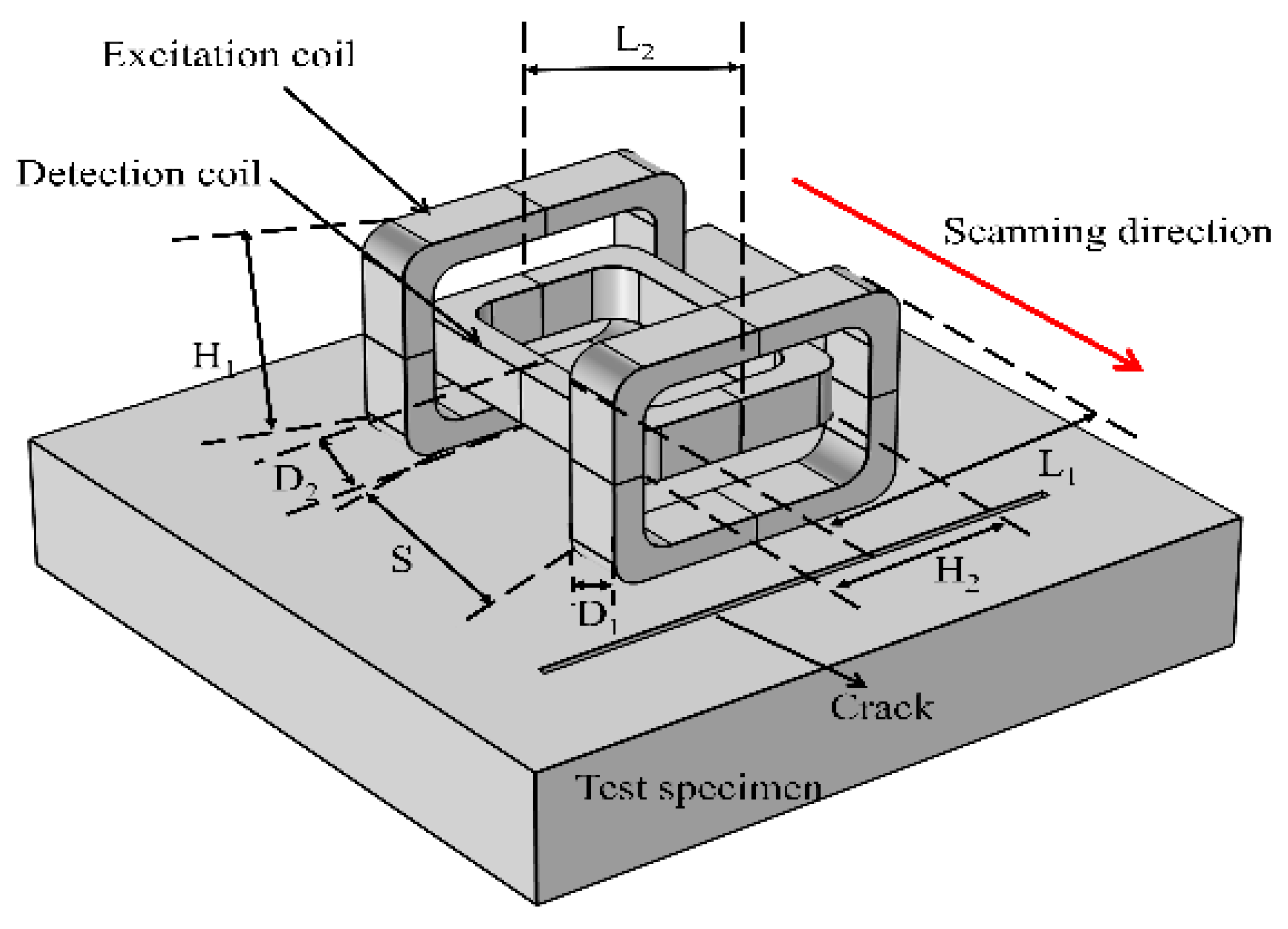
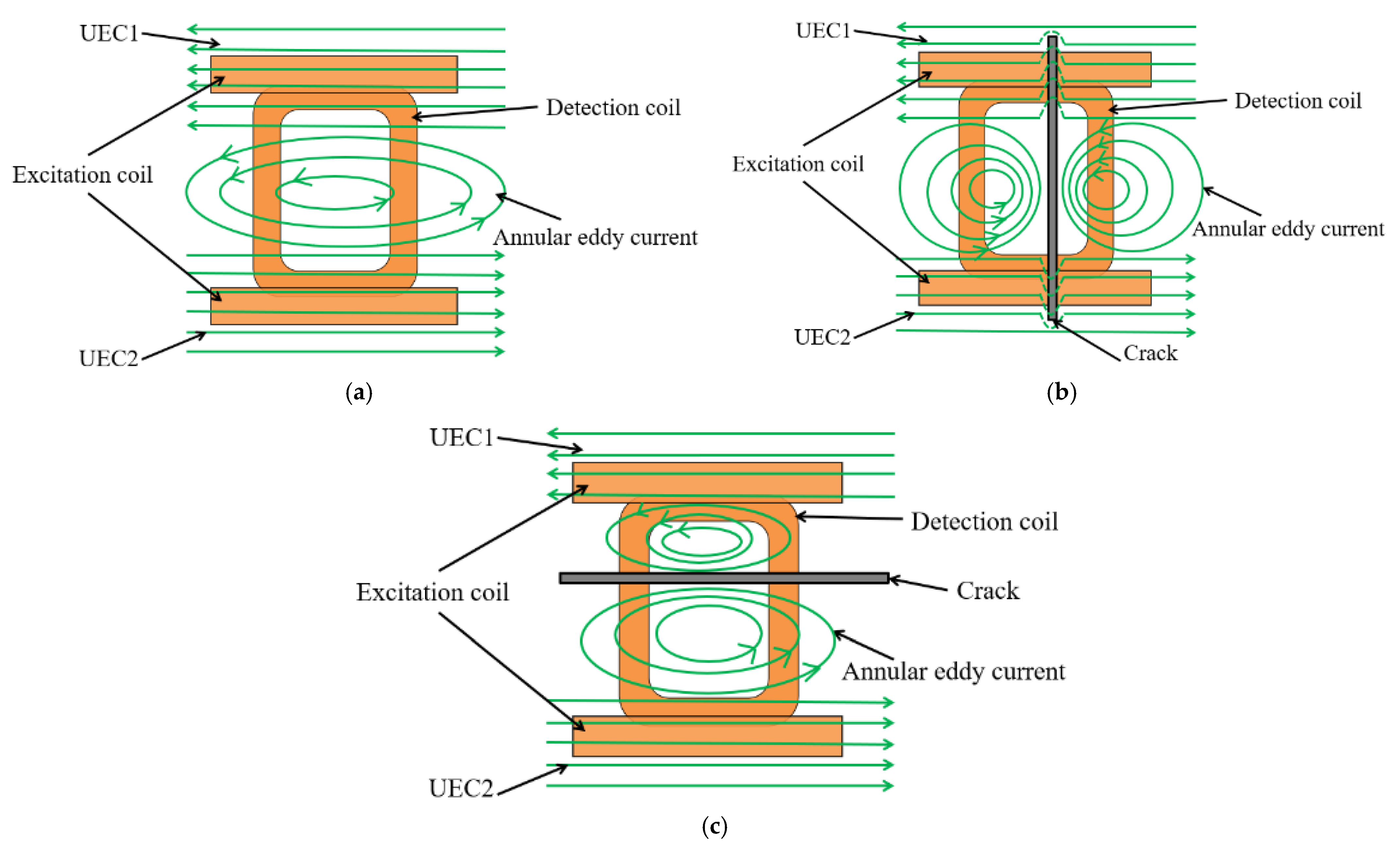

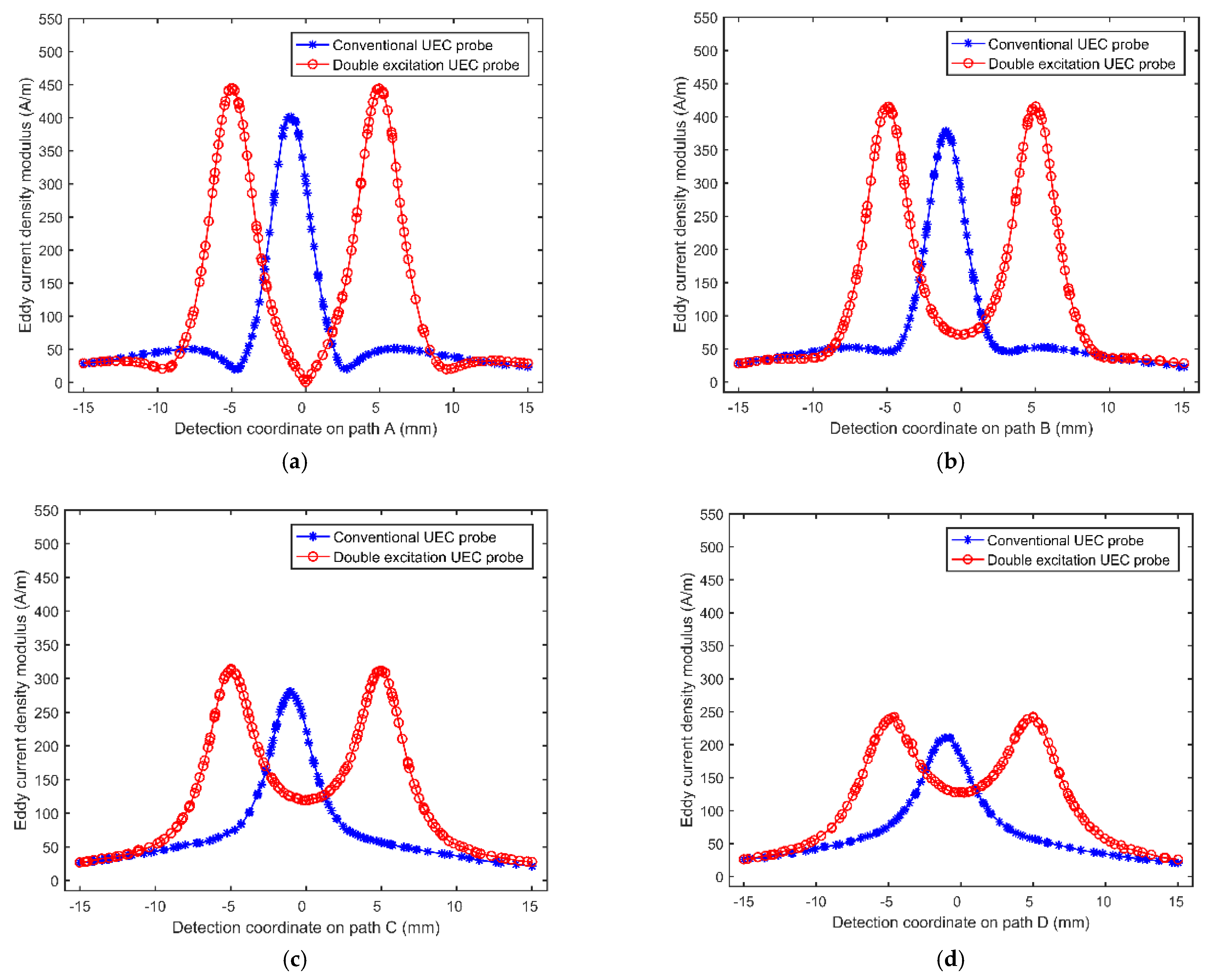
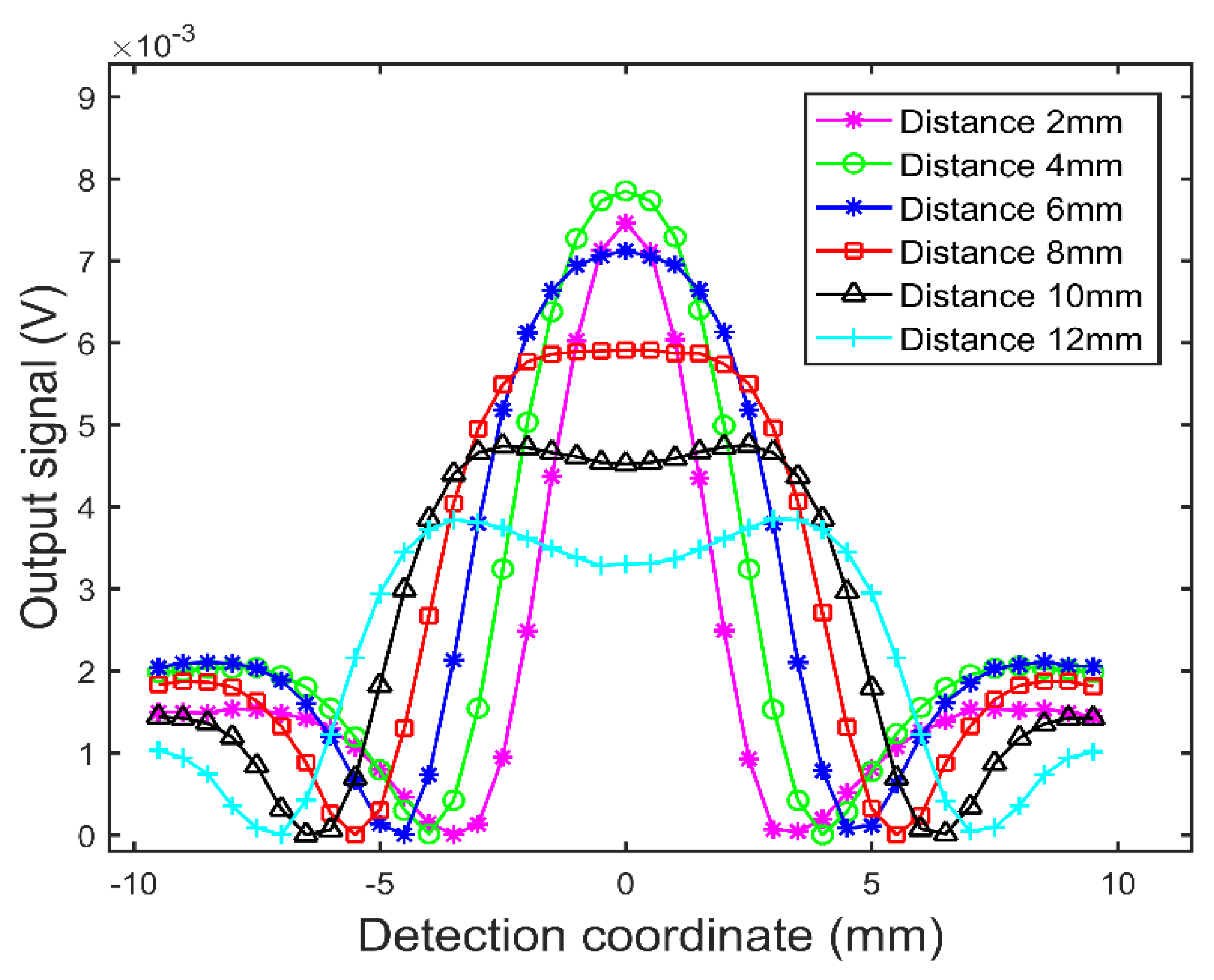

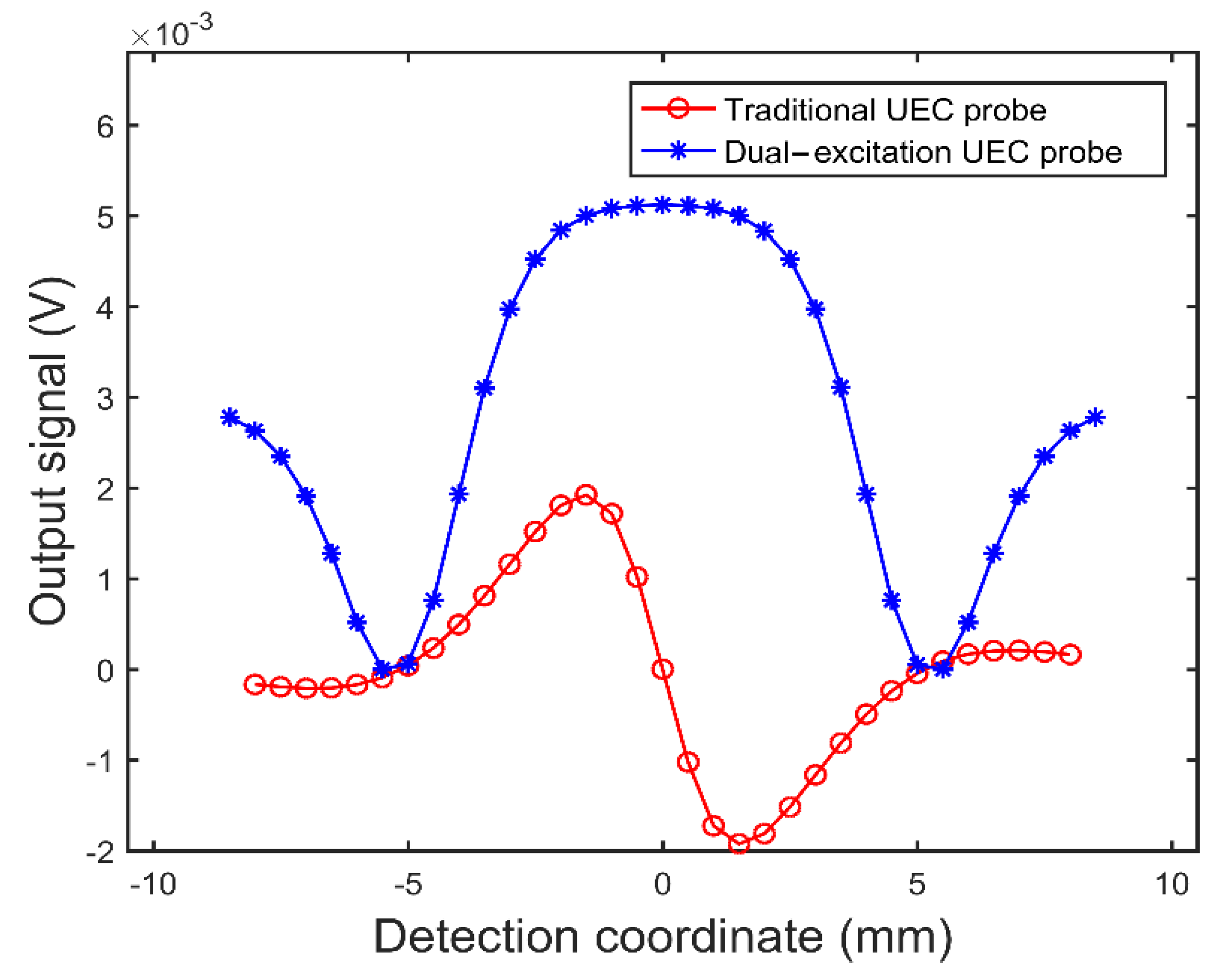
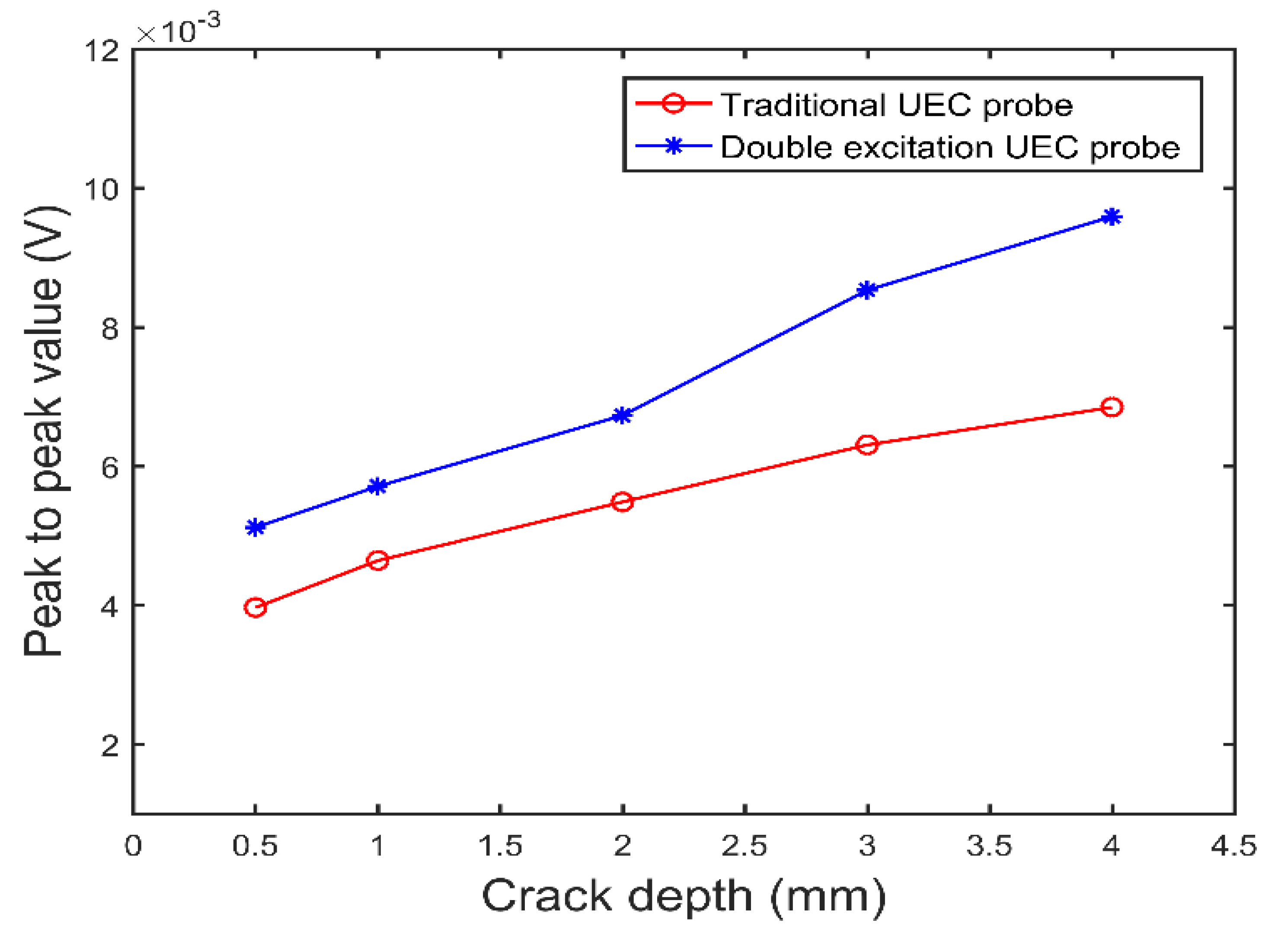
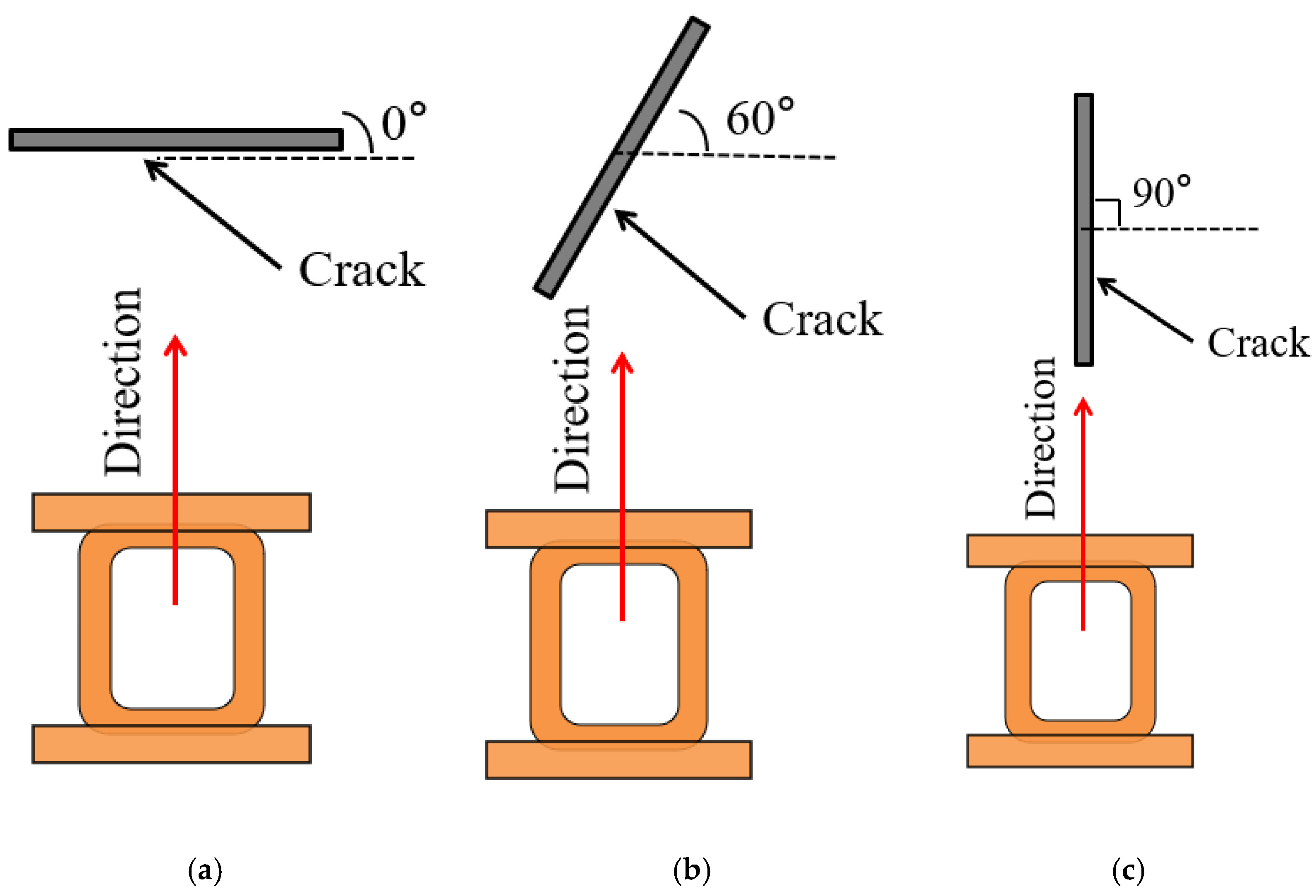

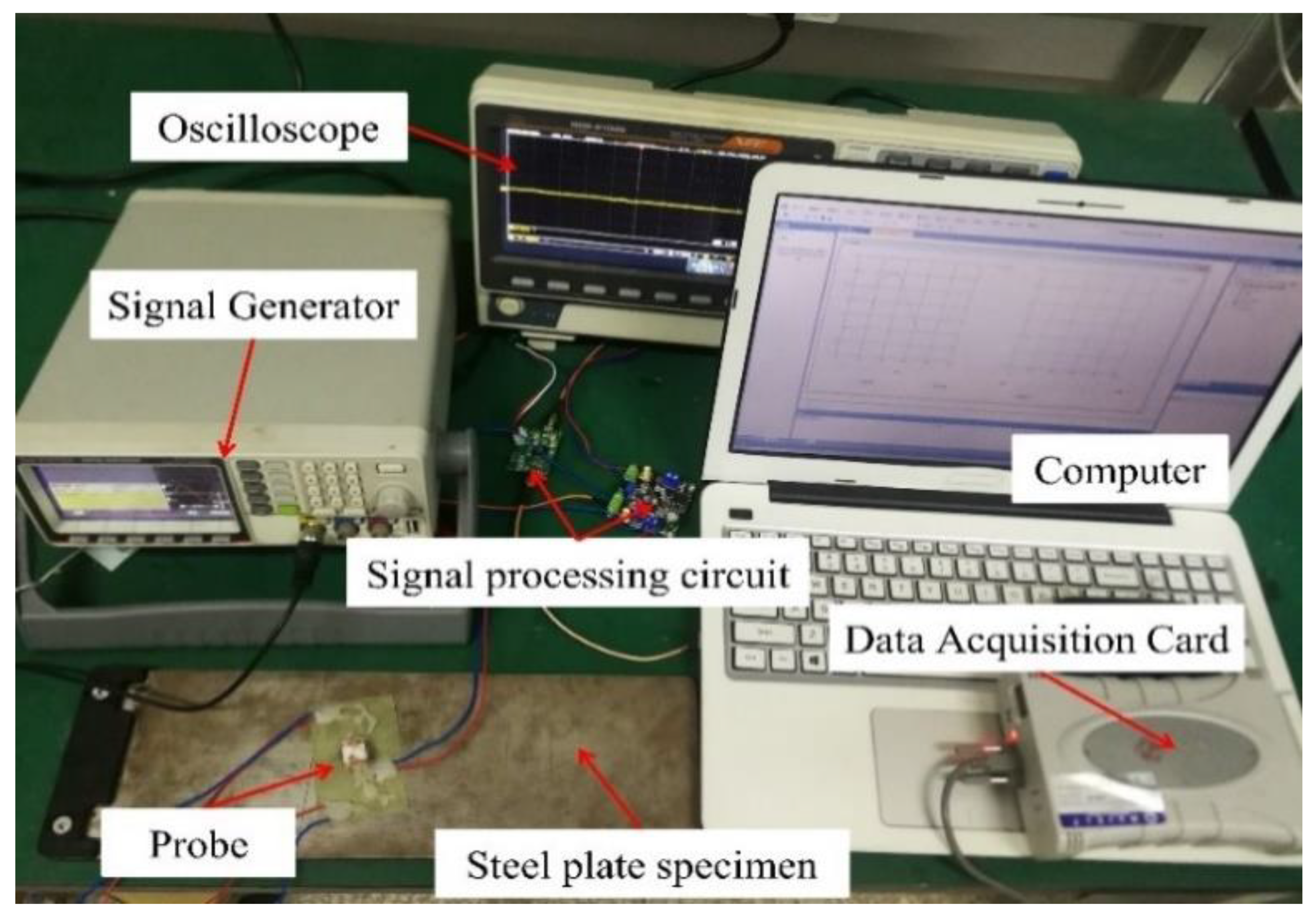
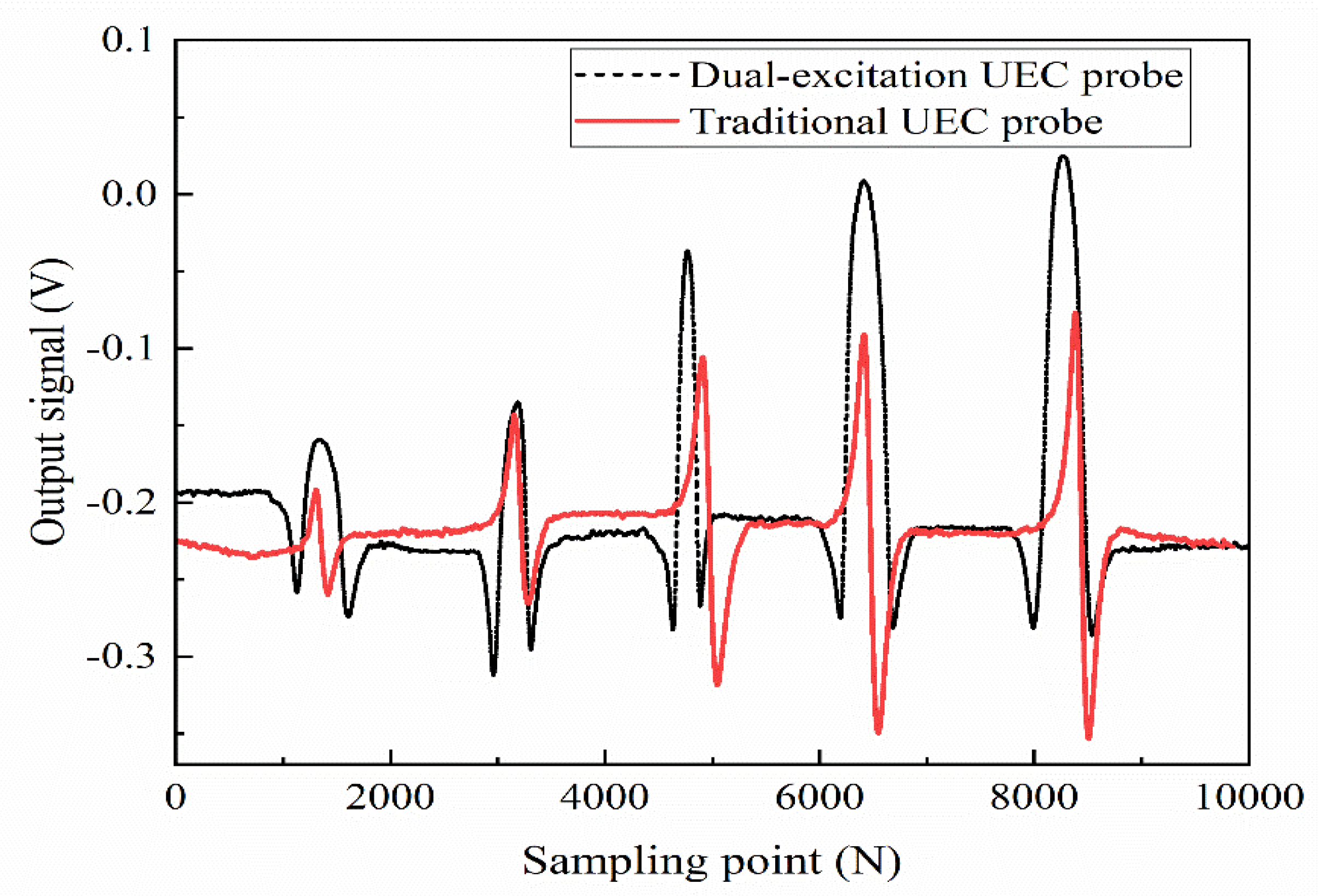
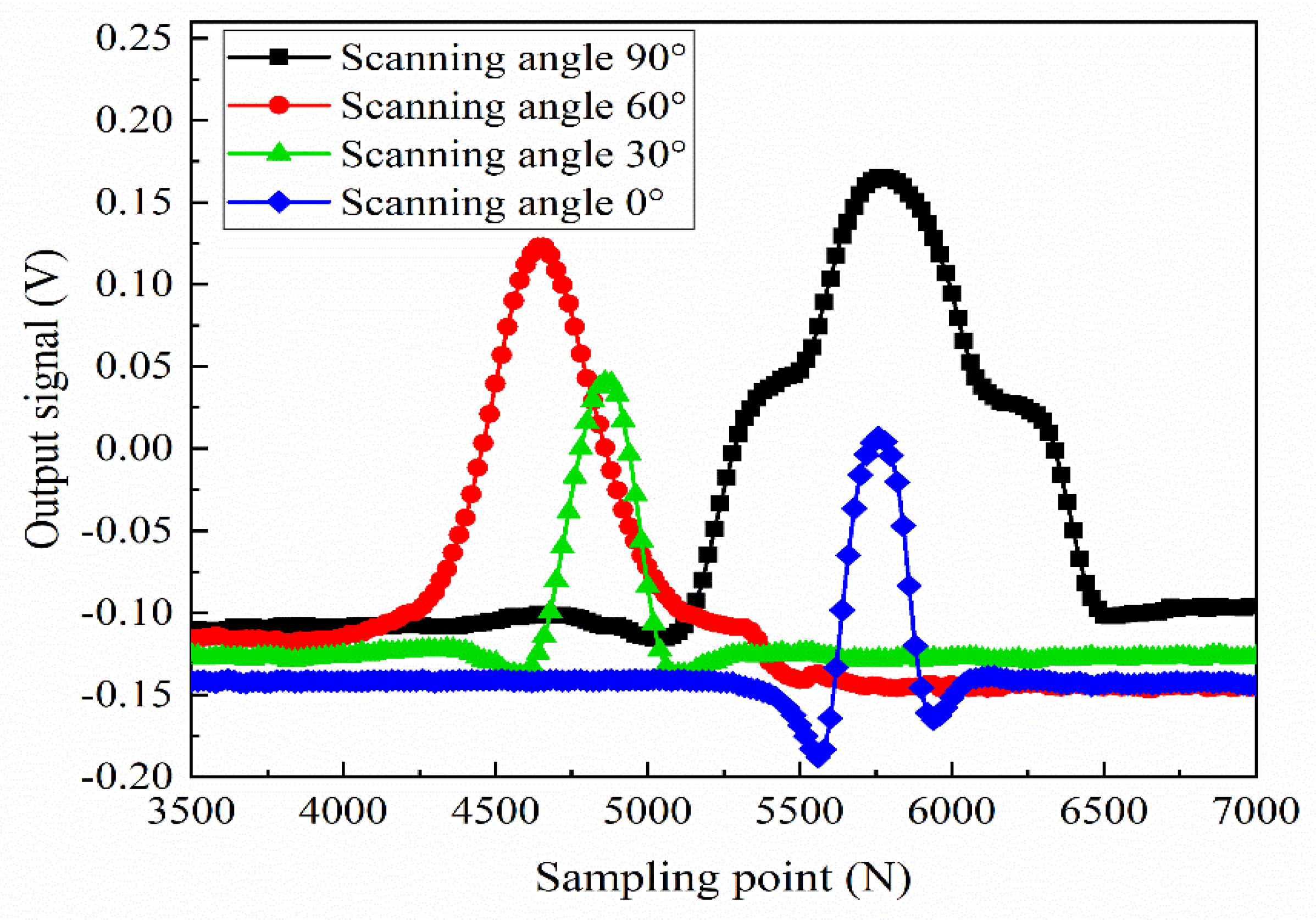

| Parameter | Excitation Coil | Detection Coil |
|---|---|---|
| Length (mm) | L1 = 10 | L2 = 10 |
| Width (mm) | D1 = 2 | D2 = 2 |
| Height (mm) | H1 = 8 | H2 = 7.6 |
| Air area radius (mm) | R = 50 | |
| Spacing (mm) | S = 8 |
| Material | Attributes | Conductivity (S/m) | Relative Permeability |
|---|---|---|---|
| Coil | copper | 5.998 × 107 | 1 |
| Carbon steel plate | iron | 1.12 × 107 | 500 |
| Air area | air | 10 | 1 |
Publisher’s Note: MDPI stays neutral with regard to jurisdictional claims in published maps and institutional affiliations. |
© 2022 by the authors. Licensee MDPI, Basel, Switzerland. This article is an open access article distributed under the terms and conditions of the Creative Commons Attribution (CC BY) license (https://creativecommons.org/licenses/by/4.0/).
Share and Cite
Chen, T.; Shi, H.; Dong, Y.; Lv, C.; Deng, Z.; Song, X.; Liao, C. Design and Performance Research of a New Dual-Excitation Uniform Eddy Current Probe. Sensors 2022, 22, 8850. https://doi.org/10.3390/s22228850
Chen T, Shi H, Dong Y, Lv C, Deng Z, Song X, Liao C. Design and Performance Research of a New Dual-Excitation Uniform Eddy Current Probe. Sensors. 2022; 22(22):8850. https://doi.org/10.3390/s22228850
Chicago/Turabian StyleChen, Tao, Hai Shi, Yuanhang Dong, Cheng Lv, Zhiyang Deng, Xiaochun Song, and Chunhui Liao. 2022. "Design and Performance Research of a New Dual-Excitation Uniform Eddy Current Probe" Sensors 22, no. 22: 8850. https://doi.org/10.3390/s22228850





